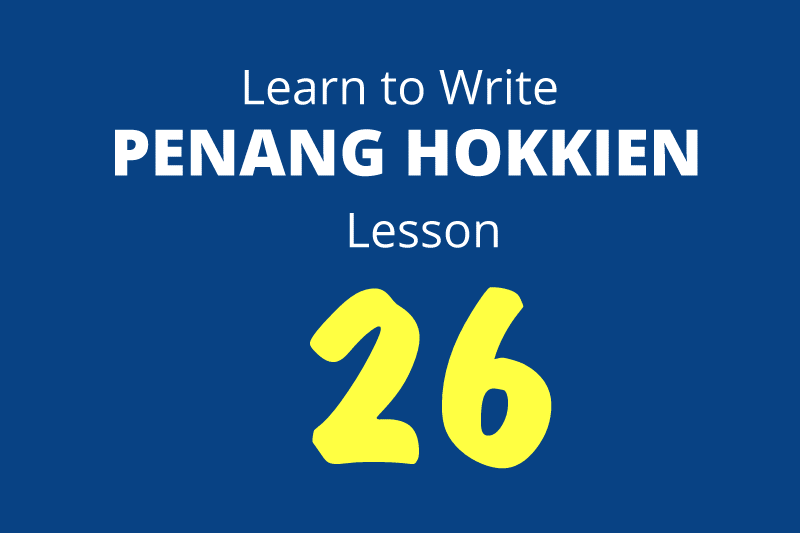
This lesson is about adpositions in Penang Hokkien. These are "location words" comprising Prepositions and Postpositions. Words like in, on, above, inside, outside, up, down, left, right, and so on.
Perhaps the most common adposition in Penang Hokkien is the preposition ti1
 . Depending on usage, it can be translated as at, in, on or over.
. Depending on usage, it can be translated as at, in, on or over.Ie1 ti1 ok3tng2.

He's at school.
Ie1 ti1 Ipoh.

He's in Ipoh.
Ie1 ceh33 ti1 kau3ie4.

He's sitting on the chair.
Ie1 ti1 heh1-peng2.

He's is over there.
Some adjectives also hold adposition properties.
Cit1-leh1 si33 wah1-eh3 gua33 ma4.

This is my maternal grandmother. (lit.: "external" grandmother)
Heh1-leh1 si33 wah1-eh3 lai33 kong4.
 That is my paternal grandfather. (lit.: "internal" grandfather)
That is my paternal grandfather. (lit.: "internal" grandfather)Some adpositions also serve as adjectives.
Wah1 e33 hien33tiok3 lu1-eh3 lai33bin33 khor3.

I can see your underpants. (lit.: inside pants)
Adverbs can also hold adposition properties, and vice versa. They include cit1-peng2
 (here), heh1-peng2
(here), heh1-peng2  (there), cnia1chiu4
(there), cnia1chiu4  (right), to1chiu4
(right), to1chiu4  (left).
(left).When cit1-peng2 and heh1-peng2 are used, the adposition ti1 is optional.
Ie1 ceh33 ti1 cit1-peng2./Ie1 ceh33 cit1peng2.

He sits here.
Wah1lang2 wan3 cnia1chiu4.
 We turned right.
We turned right.The majority of adpositions in Penang Hokkien are postposition, because they appear after the object, to show the location of the object. They almost always include the morpheme bin33
 , which means "face" or "surface", and peng2
, which means "face" or "surface", and peng2  , which means "side". They are:
, which means "side". They are:inside: lai33bin33
 , lai33bin33 peng2
, lai33bin33 peng2 
outside: gua33bin33
 , gua33bin33 peng2
, gua33bin33 peng2  , gua33khau1 peng2
, gua33khau1 peng2 
middle: teong3ng1
 , teong3ng3 peng2
, teong3ng3 peng2 
above: teng1bin33
 , teng1bin33 peng2
, teng1bin33 peng2 
under, underneath, below: e3te4
 , e3te1 peng2
, e3te1 peng2 
beside: pni1nya4
 , pni1nya1 peng2
, pni1nya1 peng2 
Here's how you use the above postpositions. Where the object is shown, attach "-eh3" to it and then the postposition. The words gua33bin33 and gua33khau4 have the same meaning, but for lai33bin33 there is no "lai33khau4".
Ie1 ti1 lai33bin33. Ie1 ti1 chu3-eh3 lai33bin33./Ie1 ti1 chu33-eh3 lai33bin33 peng2.

He's inside. He is inside the house.
Wah1 ti1 gua33bin33. Wah1 ti1 chu3-eh3 gua33khau4.
 I'm outside. I am outside the house.
I'm outside. I am outside the house.Where a verb is already present immediately before the adposition ti1, it is often dropped in daily conversations. I mark ti1 with * where it is often dropped.
Wah1 ceh33 ti1* ie1lang2 nor33 lang2-eh3 teong3ng1.

I sat between the two of them.
Ee1 haeh33 ee1-eh3 chaek3 ti1 teng1bin33. Ee1 haeh33 ee1-eh3 chaek3 ti1 tu2-eh3 teng1bin33.

She put her book on top. She put her book at the top part of the cupboard.
Ie1 thau3bi1 ti1* e3te4. Ie1 thau3bi1 ti1* chia1-eh3 e3te4.

He hid below. He hid under the car.
Ie1 ceh33 ti1* wah1-eh3 pni1nya4.

He sits beside me.
Previous Lesson | Main Page | Next Lesson
Language Learning Tools
Use the following language learning tools to learn Penang Hokkien!Learn Penang Hokkien with uTalk
This app opens the door to over 150 languages.Return to Penang Hokkien Resources

Copyright © 2003-2025 Timothy Tye. All Rights Reserved.

 Go Back
Go Back
